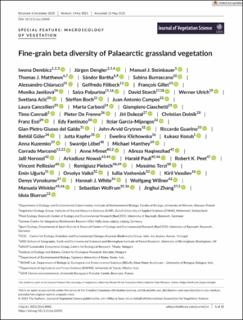Fine-grain beta diversity of Palaearctic grassland vegetation
| dc.contributor.author | Dembicz, Iwona | |
| dc.contributor.author | Dengler, Jürgen | |
| dc.contributor.author | Steinbauer, Manuel J. | |
| dc.contributor.author | Matthews, Thomas J. | |
| dc.contributor.author | Bartha, Sándor | |
| dc.contributor.author | Burrascano, Sabina | |
| dc.contributor.author | Chiarucci, Alessandro | |
| dc.contributor.author | Filibeck, Goffredo | |
| dc.contributor.author | Gillet, François | |
| dc.contributor.author | Janišová, Monika | |
| dc.contributor.author | Palpurina, Salza | |
| dc.contributor.author | Storch, David | |
| dc.contributor.author | Ulrich, Werner | |
| dc.contributor.author | Aćić, Svetlana | |
| dc.contributor.author | Boch, Steffen | |
| dc.contributor.author | Campos, Juan Antonio | |
| dc.contributor.author | Cancellieri, Laura | |
| dc.contributor.author | Carboni, Marta | |
| dc.contributor.author | Ciaschetti, Giampiero | |
| dc.contributor.author | Conradi, Timo | |
| dc.contributor.author | De Frenne, Pieter | |
| dc.contributor.author | Dolezal, Jiri | |
| dc.contributor.author | Dolnik, Christian | |
| dc.contributor.author | Essl, Franz | |
| dc.contributor.author | Fantinato, Edy | |
| dc.contributor.author | García-Mijangos, Itziar | |
| dc.contributor.author | del Galdo, Gian Pietro Giusso | |
| dc.contributor.author | Grytnes, John Arvid | |
| dc.contributor.author | Guarino, Riccardo | |
| dc.contributor.author | Güler, Behlul | |
| dc.contributor.author | Kapfer, Jutta | |
| dc.contributor.author | Klichowska, Ewelina | |
| dc.contributor.author | Kozub, Łukasz | |
| dc.contributor.author | Kuzemko, Anna | |
| dc.contributor.author | Löbel, Swantje | |
| dc.contributor.author | Manthey, Michael | |
| dc.contributor.author | Marcenó, Corrado | |
| dc.contributor.author | Mimet, Anne | |
| dc.contributor.author | Naqinezhad, Alireza | |
| dc.contributor.author | Noroozi, Jalil | |
| dc.contributor.author | Nowak, Arkadiusz | |
| dc.contributor.author | Pauli, Harald | |
| dc.contributor.author | Peet, Robert K. | |
| dc.contributor.author | Pellissier, Vincent | |
| dc.contributor.author | Pielech, Remigiusz | |
| dc.contributor.author | Terzi, Massimo | |
| dc.contributor.author | Uğurlu, Emin | |
| dc.contributor.author | Valko, Orsolya | |
| dc.contributor.author | Vasheniak, Iuliia | |
| dc.contributor.author | Vassilev, Kiril | |
| dc.contributor.author | Vynokurov, Denys | |
| dc.contributor.author | White, Hannah J. | |
| dc.contributor.author | Willner, Wolfgang | |
| dc.contributor.author | Winkler, Manuela | |
| dc.contributor.author | Wolfrum, Sebastian | |
| dc.contributor.author | Zhang, Jinghui | |
| dc.contributor.author | Biurrun, Idoia | |
| dc.date.accessioned | 2022-03-28T13:15:05Z | |
| dc.date.available | 2022-03-28T13:15:05Z | |
| dc.date.created | 2021-11-15T13:46:09Z | |
| dc.date.issued | 2021 | |
| dc.identifier.issn | 1100-9233 | |
| dc.identifier.uri | https://hdl.handle.net/11250/2988080 | |
| dc.description.abstract | Questions: Which environmental factors influence fine-grain beta diversity of vegetation and do they vary among taxonomic groups? Location: Palaearctic biogeographic realm. Methods: We extracted 4,654 nested-plot series with at least four different grain sizes between 0.0001 m² and 1,024 m² from the GrassPlot database, covering a wide range of different grassland and other open habitat types. We derived extensive environmental and structural information for these series. For each series and four taxonomic groups (vascular plants, bryophytes, lichens, all), we calculated the slope parameter (z-value) of the power law species–area relationship (SAR), as a beta diversity measure. We tested whether z-values differed among taxonomic groups and with respect to biogeographic gradients (latitude, elevation, macroclimate), ecological (site) characteristics (several stress–productivity, disturbance and heterogeneity measures, including land use) and alpha diversity (c-value of the power law SAR). Results: Mean z-values were highest for lichens, intermediate for vascular plants and lowest for bryophytes. Bivariate regressions of z-values against environmental variables had rather low predictive power (mean R² = 0.07 for vascular plants, less for other taxa). For vascular plants, the strongest predictors of z-values were herb layer cover (negative), elevation (positive), rock and stone cover (positive) and the c-value (U-shaped). All tested metrics related to land use (fertilization, livestock grazing, mowing, burning, decrease in naturalness) led to a decrease in z-values. Other predictors had little or no impact on z-values. The patterns for bryophytes, lichens and all taxa combined were similar but weaker than those for vascular plants. Conclusions: We conclude that productivity has negative and heterogeneity positive effects on z-values, while the effect of disturbance varies depending on type and intensity. These patterns and the differences among taxonomic groups can be explained via the effects of these drivers on the mean occupancy of species, which is mathematically linked to beta diversity. | en_US |
| dc.language.iso | eng | en_US |
| dc.publisher | Wiley | en_US |
| dc.rights | Navngivelse 4.0 Internasjonal | * |
| dc.rights.uri | http://creativecommons.org/licenses/by/4.0/deed.no | * |
| dc.title | Fine-grain beta diversity of Palaearctic grassland vegetation | en_US |
| dc.type | Journal article | en_US |
| dc.type | Peer reviewed | en_US |
| dc.description.version | publishedVersion | en_US |
| dc.rights.holder | Copyright 2021 the authors | en_US |
| dc.source.articlenumber | e13045 | en_US |
| cristin.ispublished | true | |
| cristin.fulltext | original | |
| cristin.qualitycode | 1 | |
| dc.identifier.doi | 10.1111/jvs.13045 | |
| dc.identifier.cristin | 1954687 | |
| dc.source.journal | Journal of Vegetation Science (JVS) | en_US |
| dc.identifier.citation | Journal of Vegetation Science (JVS). 2021, 32 (3), e13045. | en_US |
| dc.source.volume | 32 | en_US |
| dc.source.issue | 3 | en_US |
Tilhørende fil(er)
Denne innførselen finnes i følgende samling(er)
-
Department of Biological Sciences [2217]
-
Registrations from Cristin [9492]

